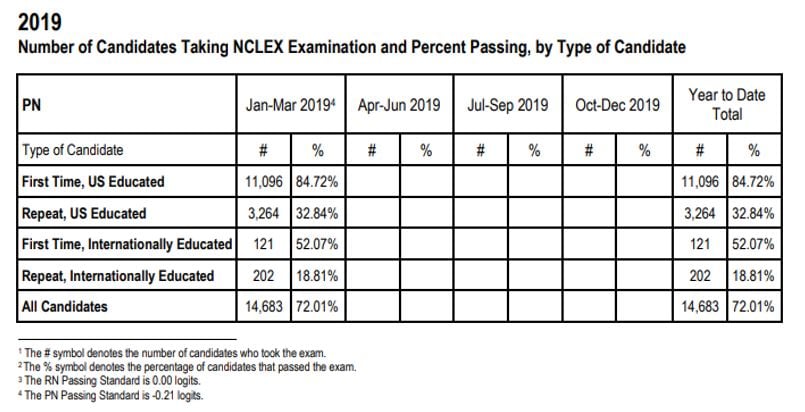NCLEX-PN Exam

What is the NCLEX?
Are you in search of a FREE practice test for the NCLEX-PN Exam? We provide a practice exam comprising 150 questions with explanations for you. The NCLEX, which stands for the National Council Licensure Examination, is usually accompanied by two other letters: either PN or RN. These letters indicate whether the exam is designed for Practical Nurses or Registered Nurses.
The purpose of the NCLEX is to assess the competency of nursing school graduates, ensuring they can practice safely as new nurses. Administered through Computerized Adaptive Testing (explained in more detail here), the CAT system ensures that each test is unique. Candidates undergo an individualized and personalized testing experience. The National Council of State Boards of Nursing (NCSBN) produces the NCLEX exams. Annually, the NCSBN surveys newly licensed nurses to update and maintain the relevance of the NCLEX, aligning the test with the real-world responsibilities of nurses.

Struggling to meet your deadline?
Get your assignment on NCLEX-PN Exam done by certified MDs and PhDs in the USA. ORDER NOW!
Established in 1978 as a non-profit and independent organization, the NCSBN was founded with the mission of safeguarding public safety. It operates on the principle that the regulation of nurses should be a distinct entity separate from the organization representing professional nurses.

2019 NCLEX-PN Pass Rates

Source: https://www.ncsbn.org/Table_of_Pass_Rates_2019.pdf
Past Years NCLEX-PN Pass Rates (First Time, US Educated)
- 2018 – 47,031 Takers, 85.91% Pass
- 2017 – 46,939 Takers, 83.84% Pass
- 2016 – 47,284 Takers, 83.73% Pass
- 2015 – 50,958 Takers, 81.89% Pass
- 2014 – 55,489 Takers, 82.16% Pass
- 2013 – 58,574 Takers, 84.63% Pass
- 2012 – 63,350 Takers, 84.26% Pass
- 2011 – 65,334 Takers, 84.83% Pass
- 2010 – 66,831 Takers, 87.05% Pass
Please note: The above numbers reflect first time test taker pass rates.
What Information Is Covered in the NCLEX-PN?
The NCLEX-PN exam questions are designed to be challenging, as the NCLEX is not an ordinary test. The National Council of State Boards of Nursing (NCSBN) emphasizes high-level thinking since nurses need to be both knowledgeable and safe in their practice. Unlike tests that rely on memorization or simple fill-in-the-blank answers, the NCLEX focuses on application and analysis questions. These types of questions demand a solid foundational knowledge, understanding of the subject matter, critical thinking skills, and the ability to make informed decisions. Together, these aspects showcase a nurse’s competence and readiness to practice.
The content of the NCLEX-PN falls into four primary categories, each with various subcategories, all centered around client needs. Nurses need to leverage their understanding of medical procedures, assessment techniques, and more to provide optimal care to their clients. The questions from these categories are interspersed randomly throughout the exam rather than being presented in distinct sections.
1. Safe Effective Care Environment:
– Management of care
– Safety and infection control
– Health promotion and maintenance
2. Psychosocial Integrity
3. Physiological Integrity:
– Basic care and comfort
– Pharmacological and parenteral therapies
– Reduction of risk potential
– Physiological adaptation
Safe and Effective Care Environment
Health Promotion and Maintenance, comprising about 12% of the total questions, focuses on preventive and proactive measures. Topics include pregnancy, birth, infant growth and development, STIs, and proper diet.
Health Promotion and Maintenance
This section covers around 12% of the total NCLEX questions. It mainly focuses on preventing health issues and taking proactive steps. The topics include pregnancy, childbirth, infant growth and development, sexually transmitted infections (STIs), and proper nutrition. Practical nursing programs often include classes on maternity, human growth and development to educate students in these areas.
Psychosocial Integrity
Approximately 12% of the questions on the NCLEX pertain to psychosocial integrity. This category covers aspects like mental health, psychiatric diseases, coping mechanisms, crisis intervention, substance abuse, and therapy. Diseases like depression, schizophrenia, eating disorders, and anxiety disorders are included. It’s crucial for students to understand the diagnosis, symptoms, and treatment of mental health disorders. Nurses must also be aware of their role in the therapeutic process and how to support patients in such situations.
Physiological Integrity
The majority of NCLEX questions fall under the physiological integrity category, ranging from 43% to 67%. This large percentage is due to the broad range of topics covered, including adult medical and surgical care, pediatric care, gerontology, and infectious diseases. Practical nursing students learn and apply this information in various courses such as medical-surgical nursing, pediatrics, gerontology, pharmacology, and more.
It’s important to note that the information provided specifically relates to the NCLEX-PN examination. The NCLEX-RN is a distinct test evaluating different knowledge and problem-solving methods, even though some topics overlap. Many practical nurses pursue further education to become registered nurses, leading them to take both exams.
For the NCLEX-RN, the content is divided into seven categories: safe and effective care/environment management of care (17-23%), safety and infection control (9-15%), health promotion and maintenance (6-12%), psychosocial integrity (6-12%), physiological integrity/basic care and comfort (6-12%), pharmacological and parenteral therapies/reduction of risk potential (9-15%), and physiological adaptation (11-17%).
NCLEX-PN Essentials and NCLEX-PN by the Numbers (According to NCBSN)
– Number of questions: NCLEX-PN has between 85 and 205 questions.
– Average number of questions: 112.
– Percent of test takers receiving the minimum number of questions: 57.2%.
– Percent of test takers receiving the maximum number of questions: 13.5%.
– Minimum test taking time: none.
– Average testing time per candidate: 2 hours and 14 minutes.
– Maximum time allowed for NCLEX-PN examination: 5 hours.
– Percent of candidates using the maximum time allowed: 1.1%.
– Number of NCLEX-PN test takers in 2016: 64,509.
– Number of internationally educated candidates taking the NCLEX-PN in 2016 (First Time): 1,079.
– Percent of first-time, U.S. educated test takers passing on the first attempt in 2016: 83.73%.
– Cost of the NCLEX-PN: $200 (may vary depending on State Board of Nursing fees).
– Payment methods for NCLEX-PN: credit card, debit card, or prepaid card (no cash or check).
Computerized Adaptive Testing (CAT)
The NCLEX-PN utilizes CAT to efficiently and fairly assess candidates. NCSBN explains that CAT combines computer technology with modern measurement theory to enhance the effectiveness of the exam process.
CAT offers several advantages over traditional methods of test administration and scoring:
Provides a dependable and precise measurement of nursing competency.
Reduces the occurrence of excessively easy or difficult questions, which can negatively impact results.
Decreases exposure to specific items, thereby minimizing security risks.
NCSBN provides various definitions related to CAT to improve comprehension of the CAT process. Candidate ability refers to the level of entry-level nursing knowledge, skills, and abilities possessed by the candidate. Ability estimate is the level of entry-level nursing knowledge, skills, and abilities determined by the computer for the candidate. Passing standard is a cutoff point on an ability range, indicating the minimum ability level required for safe and effective entry-level nursing practice. Logit is a unit of measurement used to report relative differences between candidate ability estimates and item difficulties. CAT has been employed for the NCLEX examination since 1994.
CAT operates by categorizing questions and assigning them difficulty levels. After each question is answered, the computer re-estimates the candidate’s ability based on previous questions, their difficulty levels, and correct/incorrect responses. The computer then presents a question for which the candidate should have a 50% chance of answering correctly. With each question and answer, the computer recalculates these figures to provide a precise assessment of knowledge. If a question is answered correctly, the computer selects a more challenging question; if answered incorrectly, an easier question is presented. This process continues until a pass/fail decision can be reached.
CAT employs three rules for scoring candidates and determining pass or fail:
The 95% confidence interval rule: A decision is made when the computer system is 95% confident that a candidate’s ability is clearly above or below the passing standard.
The maximum-length exam rule: If a candidate’s ability is close to the passing standard and the maximum number of questions is reached, a pass or fail decision is based on the final ability estimate.
The Run-out-of-time Rule (ROOT Rule): If a candidate runs out of time before reaching the maximum number of questions, the computer uses the last 60 questions to make a pass/fail decision.
Getting Acquainted with Pearson VUE
Pearson VUE, a part of the Pearson Company, is recognized as the leading learning company globally. Offering services from test development and management to administering licensing and certification exams, Pearson VUE plays a crucial role in nursing licensure and examination. They handle registration for test-taking and administer exams in technologically advanced facilities. Pearson VUE has an extensive network of testing centers worldwide.
Registration Procedure through Pearson VUE
Pearson VUE is the exclusive administrator for the NCLEX examinations, provided only as computerized tests. The registration process outlined by Pearson VUE is as follows:
Submit an application for licensure to the relevant Board of Nursing.
Meet all eligibility requirements specified by the Board of Nursing.
Register for the NCLEX with Pearson VUE, either online or by telephone. Online registration is quicker and more convenient.
Receive an NCLEX registration acknowledgment email from Pearson VUE.
The Board of Nursing makes the candidate eligible to test in the Pearson VUE system.
Receive the Authorization to Test form (ATT) via email from Pearson VUE. The ATT is valid for up to 90 days; if unused within this period, it must be obtained again.
Scheduling a specific examination location and time with Pearson VUE follows.
NCLEX-PN Exam Day
Before arriving at the testing center, ensure you have proper identification, as testing will not be permitted without it. Pearson VUE recommends dressing comfortably, with restrictions on hats, gloves, scarves, and coats in the testing room. Lockers are available at Pearson VUE testing centers. Arriving 30 minutes before the test is advised; being more than 30 minutes late results in forfeiting the test and any fees paid.
Upon arrival, Pearson VUE employees verify identity and other details. Advanced security measures, including a photograph, signature, and palm vein scan, are required. Inside the testing centers, audio and video recording monitor all test-takers for fairness, security, and prevention of cheating. Outside materials, including paper and writing utensils, are typically not allowed. Test-takers are provided with an on-screen calculator and a dry erase board with a marker.
On exam day, maintaining a proper pace is crucial, with no reward for finishing early. The time limit for the NCLEX-PN is 5 hours, with two breaks provided.
After completing the test, a short survey is presented. Test administrators dismiss candidates, but results are not immediately available. They undergo a second verification process for correct scoring and pass/fail decisions.
After Completing the NCLEX-PN
While awaiting results may be nerve-wracking, there is a delay between taking the test and receiving results. “Unofficial results” are typically available within 48 business hours. Some candidates choose to pay for the optional “Quick Results Service” for $7.95, although unpaid results are often obtained at a similar time-frame.
Official results are only accessible through the State Board of Nursing, mailed about 6 weeks after the test. If the result is a passing score, candidates receive this news only, without an exact score. If the candidate fails, they receive a notice and a NCLEX Candidate Performance Report (CPR). The CPR, a two-page document, provides individualized feedback to help candidates pass the NCLEX on a second attempt, including information about CAT on the first page.
The CPR analyzes which types of questions were answered correctly and incorrectly, identifying strengths and weaknesses in each category. Individual questions and answers are not provided, focusing instead on improving study habits based on categories of information and question types.
Retaking the NCLEX-PN
Candidates failing the examination the first time are allowed to retake it. Depending on the board of nursing, a waiting period of 45 to 90 days is required before a retake can occur. The steps for retaking the NCLEX are:

Dont wait until the last minute.
Provide your requirements and let our native nursing writers deliver your assignments ASAP.
- Contact the appropriate board of nursing and notify them of the intention to retake the exam.
- Re-register with Pearson VUE and pay the $200 fee again.
- Wait to receive a new ATT.
- Schedule a new exam.

